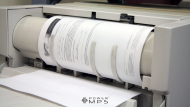Technological advancements have made inter-and-external-office communications faster, more streamlined, and generally paperless. However, despite the decline in faxing, paper memos, and direct mail, printing remains an essential function for any business. When the printers go down or there are service interruptions, it directly affects the office’s productivity.
This importance to both the home office and home office operations is exactly why office printer service providers and printer manufacturers continue to make improvements that will ensure printing continues to integrate well and perform to today’s fluctuating business needs.
Here are three interesting facts that show the importance and evolution of office printing.
1. Highly Sought After
There is something about tangible printed paper that makes people more productive. According to a recent survey from Pharos, more than half of office workers prefer to work with actual paper, while fewer than one quarter leans toward digital documentation. But it’s not just the average worker that turns to the printed word to get things done.
Most IT decision-makers think office print is essential to how businesses run today. Their opinion is supported by over 70% of up-and-coming workers aged 18 to 34. These are the people and generations shaping the future of business. Despite their clear preference for digital interactions, their reliance on print and paper in business is a clear indicator of the future outlook of office printing.
2. There is Room for Efficiency and Savings in Office Printing
 One employee or worker prints over 10,000 pages per year. That equates to approximately 27 pages daily and an average total of $725 per employee annually. But not all of those printed pages are necessary. Around 17% end up in the trash bin right off the press, and another 65% don’t make it to see the next day.
One employee or worker prints over 10,000 pages per year. That equates to approximately 27 pages daily and an average total of $725 per employee annually. But not all of those printed pages are necessary. Around 17% end up in the trash bin right off the press, and another 65% don’t make it to see the next day.
Despite the continued print and paper waste, many companies ignore around 40% of their printing costs. These hidden expenses are wrapped up in consumables, cartridges, maintenance, service, employee time, and waste.
Waste from laser printers alone in the United States accounts for around 100 lbs in annual losses. The prints thrown away represent toner, paper, and energy lost due to incorrect printing, accidental printing, or even temporary need. The costs associated with inkjet printers can be even higher as the costs for ink cartridges continue to rise.
There is a lot of room for improvement across the office printing environment. Strategies range from helping employees modify printing behaviors to updating equipment and supplies to be more energy and cost-efficient for the office size and needs. Studies from Gartner Group note the potential savings for businesses that implement office print management solutions can reach up to 30%.
3. Sometimes Savings is Just a Partnership Away
For any business, making sure you cut operating costs determines final profits and overall success. So, what are the best solutions to minimizing printer operating costs? Fortunately, it is not hard for companies to start saving money.
One of the best ways to provide the efficiency of printing while managing costs is to partner with a Managed Print Services (MPS) or other printer service provider. These businesses study printing trends, determine potential green goals, and model solutions to their office partners’ printing budgets. In addition, these solutions can help resize print configurations to fit the needs and criteria of each business.
Millennial IT managers are also rising to the challenge of tackling office printing costs and efficiencies. Rather than defaulting to the status quo, these up-and-coming leaders are looking for less expensive options that are a better fit for today’s office setting—solutions like the A4 printer.
In the past, many businesses defaulted to the larger A3 printer model. The decision made sense because printer manufacturers at the time focused heavily on that model as their flagship for the office setting. In addition, these machines were designed to produce high volumes and service large, multi-departmental offices when filing, office memos, and printed text were the primary forms of communication and storage.
Post-COVID, printer manufacturers have seen the shift to smaller office and hybrid office formats, where the sheer capacity produced by the A3 unit is not necessarily what is required. Today, higher-end A4 printers are being built with increased Wi-Fi and wireless capabilities, faster scan speeds, and more robust features, including increased support and more applications. And Millennial IT managers are here for the transition.
But that doesn’t mean there is no place in the modern office for a more robust A-3 machine. It’s possible for an office looking for lower equipment costs to move to an A4 model, only to spend additional time, energy, and money attempting to force the smaller machine to meet office needs. It’s all about sizing the machine’s performance to the appropriate business requirements.
Office printing isn’t going away anytime soon. Fortunately for today’s businesses, there are multiple ways to improve efficiencies and decrease costs while continuing to meet the needs of employees. Understanding employee needs, creating appropriate printer management rules, and partnering with a reputable office printer services business are a few of the ways any company can regain control of their printing operations.







